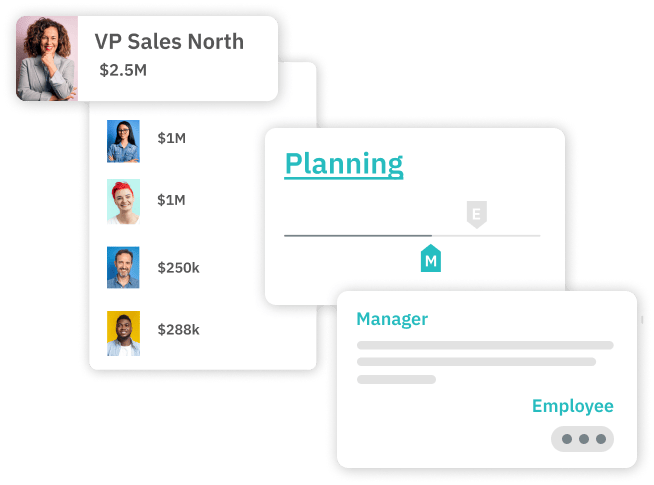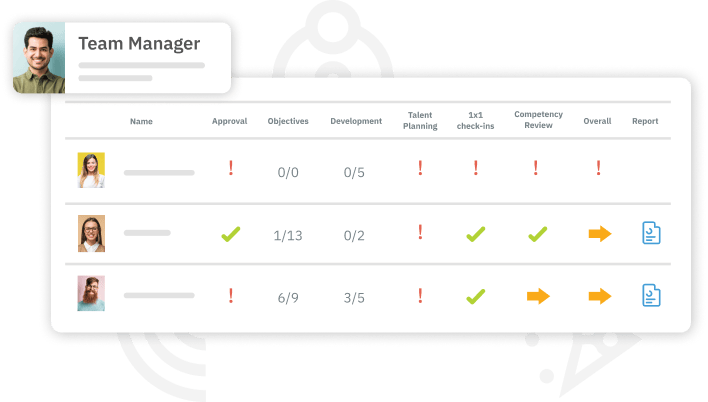Employee Performance Management Software
Ongoing feedback, continuous growth
Turn periodic performance reviews into an ongoing conversation that generates constructive feedback and meaningful, measurable improvement throughout the year with the best employee performance management software.


Real-time feedback for better learning
Performance feedback is most powerful when it happens in real time, whether it’s constructive criticism or recognition for a job well done. The performance review can be transparent between manager and employee or employee-only, or manager-only.

Multi-faceted reviews
Combine reviews of culture, soft skills, job skills, and organizational goals into one streamlined performance review. Utilize BARS or Likert scales to customize to your organizational needs.

Org-wide goal alignment
Keep everyone working towards the targets that matter by setting company or departmental goals and assigning them directly to employees.
See How Our Platform Helps You Build a Future-Ready Workforce
TalentGuard works best with organizations of 500+ employees in the U.S., Europe, Latin America, and regions within six hours of Central U.S.
Every company is at a different stage. Some need to clean up messy job titles and skills first. Others are focused on readiness, mobility, or succession.
Our bundles are built to match those realities. Pick the bundle that’s closest to where you are today, and we’ll tailor the demo to your needs. If you’re unsure whether we serve your region or use case, email info@talentguard.com and we’ll help you find the best fit.
Automate
Competency management for HR with AI automation. Create AI-powered skills, jobs, and career paths, building a strong talent management foundation.
Automate includes:
- WorkforceGPT Copilot powered by Generative AI
- Talent Frameworks: Access to industry-specific pre-built competency models
- Content Management System: Ability to create, edit, manage and map skills, jobs, learning and career progressions.
- Workflow and Approvals Automation
Engage
Enhance employee engagement and retention with impactful strategies that ensure optimal return on investment.
Everything in Automate plus:
- Talent Assessment: Assess employee skills and competencies
- Development Plan: Develop personalized learning paths
- Career Path: Advance employees with recommend career paths
- Analytics: Workforce intelligence insights and reporting
Optimize
Build a robust enterprise foundation to manage and optimize your mission-critical talent management program at scale.
Everything in Engage plus:
- Succession Planning: Build high-potential talent pools
- Performance Management: Review, set goals, & provide feedback
- Certification Tracking: Track employee certifications
- 360 Feedback: Conduct multi-rater leadership feedback
Trusted by Leading Companies Worldwide




Your Workforce is Evolving — Be Ready for What’s Next
Read our eBook
Additional information
Employee performance management is the process of continuous feedback and communication between managers and their employees to ensure the achievement of the strategic objectives of the organization. According to the University of California Berkeley, “the communication process includes clarifying expectations, setting objectives, identifying goals, providing feedback, and reviewing results.” The benefits of performance management, when executed effectively, are crucial to an organization’s growth.
But why is performance management important in human resources? Performance management in HRM can help accomplish your business’ objectives. With a performance management process in place, you can lay the foundation for matching your employee tasks with your company’s greater goals. Here’s how this breaks down:
- Shedding light on the broader purpose of an individual employee’s tasks helps them understand the purpose behind what they’re doing day in and day out, motivating them to perform well on even small projects.
- Performance management relays clear expectations to all employees, helping them understand what a “job well done” 1) looks like and 2) achieves for their team and the company as a whole.
- When performance management processes include measurable metrics and standards for success, employees understand where and how to focus their time and energy. Ideally, focused energy will lead to the reduction of time spent on unproductive tasks and the devotion of greater time to those tasks that are productive.
- Regular performance management check-ins allow for employees and managers to work together to identify bottlenecks and pain points within a project.
Performance management models can look different depending on your organization and its unique human capital structure. While some teams prefer informal, frequent daily check-ins, others may organize systematized monthly reviews. The key is to consider what works well for your company and the teams within it. For example, a team with shorter-term projects (or constant little fires to put out) may benefit from more frequent performance management discussions.
No matter the average task length or structure of your company’s teams, the importance of performance management systems should be realized by all organizations. Companies across all industries benefit from software designed to help track employee performance metrics and communicate those metrics to employees and their managers.
Performance Management Framework
While organizations should tweak their performance management outline to make it work for them, there are generally 6 steps in the process of an effective corporate performance management framework. Check out our six step performance management process below:
1) Commitment from the top
If an employee performance management process is going to be effective, you’ll need to make sure your corporate leadership team is on board. You can’t move forward without their support, which is why commitment from the top is the first in our performance management process steps. If your leadership team is struggling to understand why your teams should carve out time to devote to reviewing employee performance, consider explaining why performance management is important in accomplishing organizational goals, elaborated on in Section 1 of this post.
2) Clear objectives.
Once you’ve garnered leadership’s support, the performance management cycle beings with clear objectives. What goals does your company need to hit, and to which teams can you assign them? Once each team is familiar with its goals, have teams match every task to a relevant goal. Tasks that aren’t clearly fulfilling a goal should be scrutinized.
Once the review of all team tasks is complete, focus on the performance of each employee as they fulfill their tasks. There are many different performance management process examples and respective metrics within, but which metrics are crucial to your business? Are you known for your customer service? Are your vendor relationships make or break to you? Or are certain corporate values central to your operations, such as teamwork, efficiency, or cost-savings? Decide which standards to outline, and then communicate which behaviors and actions forward these standards, and which do not. Make it clear to your employees that succeeding within these metrics should be always top of mind.
3) Balanced feedback
Providing feedback to employees helps them understand whether they’re hitting the metrics they’re measured on, and if not, how to course correct. Feedback should be formulaic and routine whenever possible. Formulaic feedback can be created through the use of thorough performance measurement software.
4) Regular progress reviews.
While feedback should be frequent (even daily), progress reviews, which are more formal, should be done at less frequent but regular intervals. Finding the right balance between reviews that occur often enough to be helpful without wasting managers’ time will depend on your specific organization’s needs.
5) Development plans.
After several progress reviews with an employee, clear strengths and weaknesses will become identifiable. Managers can use an employee’s unique performance metrics to define long-term goals for each individual. These long-term goals (and how they will be measured) will become the outline for a development plan for each employee. Keep in mind that development plans don’t have to be centered to individual employees alone: they can also be useful for entire teams or entire metrics.
6) Capable managers
This is less of a “step” than it is a general item of importance. Managers should always be equipped with the tools they need to make the performance management process in HRM go smoothly. This can be accomplished through the use of software that helps managers track each employee’s performance according to the team’s specific metrics.
Employee Performance Management System
As described above, the importance of employee performance management cannot be understated. An effective employee performance management system functions well when managers and employees are aligned on big picture goals and day to day tasks. A performance management system process can be executed in several different ways and on different levels of sophistication. Consider the various models below. Which does your organization have, and which level would help it improve?
Performance Management System Examples:
- Informal, Unrecorded
Many companies operate on “level one” within the three types of performance management systems. When performance management is informal and recorded, it may be something that managers are thinking about, but don’t name to their employees. As a result, while standards may be communicated generally, employees might not be held accountable for clear metrics.
- Informal, Recorded
Companies who have an informal, recorded performance management process are on “level two”: they benefit from having records of how employees are doing, but they may not be tracking metrics routinely, efficiently, or effectively.
- Formal, Recorded
Companies who have formal, recorded employee performance management processes take full advantage of available resources, such as performance management tools, to measure how they’re reaching their goals. These companies use software that records goals, the metrics used to reach them, and how employee performance is helping achieve company objectives. This is “level three” performance management, and it is proven to help companies achieve their goals.
Performance Management Examples
There are always roadblocks when it comes to HR performance management. Examples, broadly, include a lack of definitive and effective metrics; no systemized measurement process; a misalignment between big picture goals and day-to-day tasks; and a missing incentivization structure. Lots can be learned from companies with best performance management practices. These roadblocks can also usually be avoided through better manager employee communication and adhering to employee performance management best practices. Performance management best practices examples that all organizations can implement are below:
- Build Acknowledgment and Praise into Your Employee Performance Management Structure
During meetings between managers and employees, praise should always be given for what employees are doing right. Often, high-performing metrics aren’t measured, since managers tend to assume they’re “covered.” But these metrics are just as important as the ones that need rehabilitation. In fact, these items are a driver for continued growth – not just in your company’s goals, but in employee morale. If you don’t have an incentive program, consider implementing one for your employees.
- Use Intelligent Software to Track Employee Performance Management Metrics
What do all the companies with the best performance management practices have in common? They use technology to track employee performance. Using intelligent software helps keeps your feedback systematized and formulaic.
- Communicate the Relation of Big Goals to Small Tasks
One of the most common roadblocks to effective employee performance management is the misalignment between big picture goals and daily interactions and tasks. Ensuring that managers are communicating the link between the company’s goals and each employee’s role can help energize employees and ensure they’re on board for seemingly small, day-to-day items.
Employee Performance Management Software
The importance of performance management to the organization can’t be stressed enough. Even still, employee performance management can be a tricky process to master and keep up manually, even for the most experienced managers and HR professionals. Performance management system software can help make the process easier on managers through the analysis of many data points. The best performance management software can even connect data for you and show you insights you may not have considered before.
Employee performance management is as its most effective when companies utilize an all-in-one program that manages all step of the talent management process in a single platform. With employee performance management software programs, information collected in the performance management stage can be used to enhance other processes, such as career pathing or succession planning.

